发电厂及电力系统毕业论文
- 格式:doc
- 大小:928.50 KB
- 文档页数:55
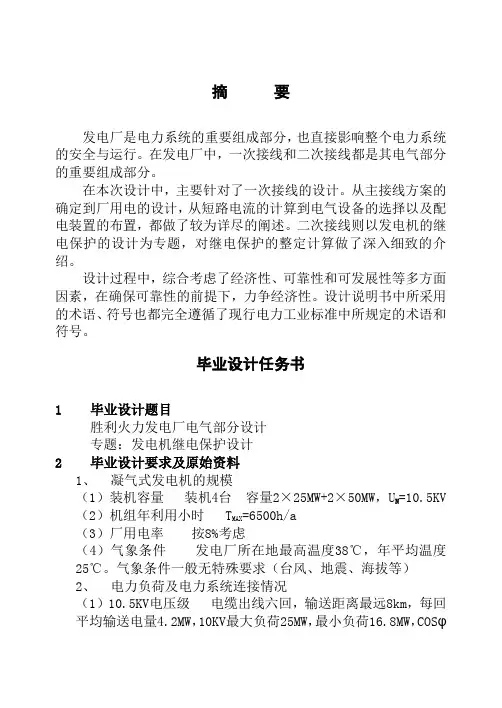
摘要发电厂是电力系统的重要组成部分,也直接影响整个电力系统的安全与运行。
在发电厂中,一次接线和二次接线都是其电气部分的重要组成部分。
在本次设计中,主要针对了一次接线的设计。
从主接线方案的确定到厂用电的设计,从短路电流的计算到电气设备的选择以及配电装置的布置,都做了较为详尽的阐述。
二次接线则以发电机的继电保护的设计为专题,对继电保护的整定计算做了深入细致的介绍。
设计过程中,综合考虑了经济性、可靠性和可发展性等多方面因素,在确保可靠性的前提下,力争经济性。
设计说明书中所采用的术语、符号也都完全遵循了现行电力工业标准中所规定的术语和符号。
毕业设计任务书1毕业设计题目胜利火力发电厂电气部分设计专题:发电机继电保护设计2毕业设计要求及原始资料1、凝气式发电机的规模(1)装机容量装机4台容量2×25MW+2×50MW,U N=10.5KV (2)机组年利用小时 T MAX=6500h/a(3)厂用电率按8%考虑(4)气象条件发电厂所在地最高温度38℃,年平均温度25℃。
气象条件一般无特殊要求(台风、地震、海拔等)2、电力负荷及电力系统连接情况(1)10.5KV电压级电缆出线六回,输送距离最远8km,每回平均输送电量4.2MW,10KV最大负荷25MW,最小负荷16.8MW,COSφ= 0.8,T max = 5200h/a。
(2)35KV电压级架空线六回,输送距离最远20km,每回平均输送容量为5.6MW。
35KV电压级最大负荷33.6MW,最小负荷为22.4MW。
COSφ=0.8, T max =5200h/a。
(3)110KV电压级架空线4回与电力系统连接,接受该厂的剩余功率,电力系统容量为3500MW,当取基准容量为100MVA时,系统归算到110KV母线上的电抗X*S = 0.083。
(4)发电机出口处主保护动作时间t pr1 = 0.1S,后备保护动作时间t pr2 = 4S。
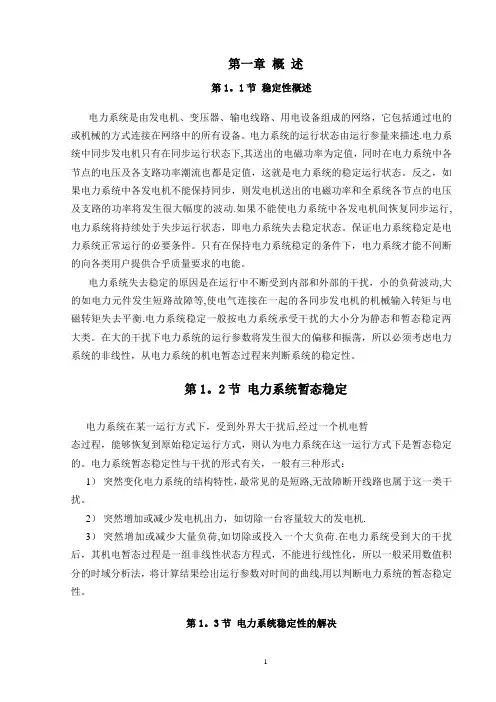
第一章概述第1。
1节稳定性概述电力系统是由发电机、变压器、输电线路、用电设备组成的网络,它包括通过电的或机械的方式连接在网络中的所有设备。
电力系统的运行状态由运行参量来描述.电力系统中同步发电机只有在同步运行状态下,其送出的电磁功率为定值,同时在电力系统中各节点的电压及各支路功率潮流也都是定值,这就是电力系统的稳定运行状态。
反之,如果电力系统中各发电机不能保持同步,则发电机送出的电磁功率和全系统各节点的电压及支路的功率将发生很大幅度的波动.如果不能使电力系统中各发电机间恢复同步运行,电力系统将持续处于失步运行状态,即电力系统失去稳定状态。
保证电力系统稳定是电力系统正常运行的必要条件。
只有在保持电力系统稳定的条件下,电力系统才能不间断的向各类用户提供合乎质量要求的电能。
电力系统失去稳定的原因是在运行中不断受到内部和外部的干扰,小的负荷波动,大的如电力元件发生短路故障等,使电气连接在一起的各同步发电机的机械输入转矩与电磁转矩失去平衡.电力系统稳定一般按电力系统承受干扰的大小分为静态和暂态稳定两大类。
在大的干扰下电力系统的运行参数将发生很大的偏移和振荡,所以必须考虑电力系统的非线性,从电力系统的机电暂态过程来判断系统的稳定性。
第1。
2节电力系统暂态稳定电力系统在某一运行方式下,受到外界大干扰后,经过一个机电暂态过程,能够恢复到原始稳定运行方式,则认为电力系统在这一运行方式下是暂态稳定的。
电力系统暂态稳定性与干扰的形式有关,一般有三种形式:1)突然变化电力系统的结构特性,最常见的是短路,无故障断开线路也属于这一类干扰。
2)突然增加或减少发电机出力,如切除一台容量较大的发电机.3)突然增加或减少大量负荷,如切除或投入一个大负荷.在电力系统受到大的干扰后,其机电暂态过程是一组非线性状态方程式,不能进行线性化,所以一般采用数值积分的时域分析法,将计算结果绘出运行参数对时间的曲线,用以判断电力系统的暂态稳定性。
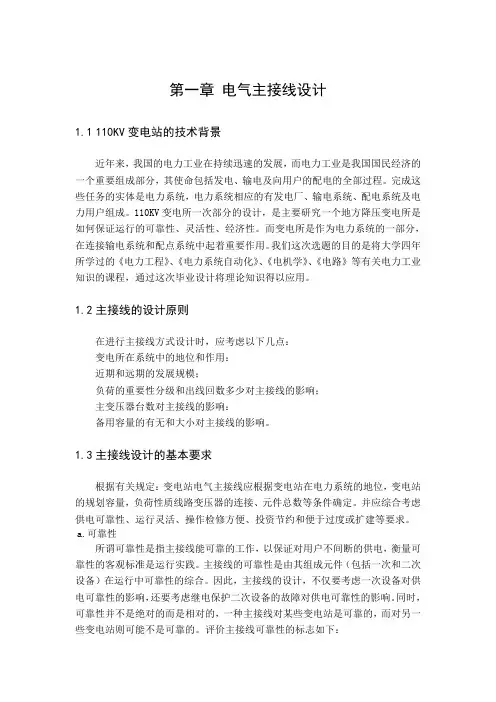
第一章电气主接线设计1.1110KV变电站的技术背景近年来,我国的电力工业在持续迅速的发展,而电力工业是我国国民经济的一个重要组成部分,其使命包括发电、输电及向用户的配电的全部过程。
完成这些任务的实体是电力系统,电力系统相应的有发电厂、输电系统、配电系统及电力用户组成。
110KV变电所一次部分的设计,是主要研究一个地方降压变电所是如何保证运行的可靠性、灵活性、经济性。
而变电所是作为电力系统的一部分,在连接输电系统和配点系统中起着重要作用。
我们这次选题的目的是将大学四年所学过的《电力工程》、《电力系统自动化》、《电机学》、《电路》等有关电力工业知识的课程,通过这次毕业设计将理论知识得以应用。
1.2主接线的设计原则在进行主接线方式设计时,应考虑以下几点:变电所在系统中的地位和作用:近期和远期的发展规模;负荷的重要性分级和出线回数多少对主接线的影响;主变压器台数对主接线的影响:备用容量的有无和大小对主接线的影响。
1.3主接线设计的基本要求根据有关规定:变电站电气主接线应根据变电站在电力系统的地位,变电站的规划容量,负荷性质线路变压器的连接、元件总数等条件确定。
并应综合考虑供电可靠性、运行灵活、操作检修方便、投资节约和便于过度或扩建等要求。
a.可靠性所谓可靠性是指主接线能可靠的工作,以保证对用户不间断的供电,衡量可靠性的客观标准是运行实践。
主接线的可靠性是由其组成元件(包括一次和二次设备)在运行中可靠性的综合。
因此,主接线的设计,不仅要考虑一次设备对供电可靠性的影响,还要考虑继电保护二次设备的故障对供电可靠性的影响。
同时,可靠性并不是绝对的而是相对的,一种主接线对某些变电站是可靠的,而对另一些变电站则可能不是可靠的。
评价主接线可靠性的标志如下:(1)断路器检修时是否影响供电;(2)线路、断路器、母线故障和检修时,停运线路的回数和停运时间的长短,以及能否保证对重要用户的供电;(3)变电站全部停电的可能性。
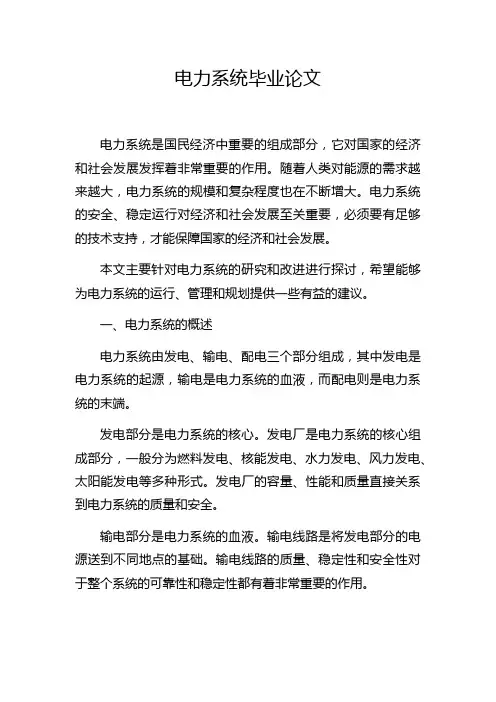
电力系统毕业论文电力系统是国民经济中重要的组成部分,它对国家的经济和社会发展发挥着非常重要的作用。
随着人类对能源的需求越来越大,电力系统的规模和复杂程度也在不断增大。
电力系统的安全、稳定运行对经济和社会发展至关重要,必须要有足够的技术支持,才能保障国家的经济和社会发展。
本文主要针对电力系统的研究和改进进行探讨,希望能够为电力系统的运行、管理和规划提供一些有益的建议。
一、电力系统的概述电力系统由发电、输电、配电三个部分组成,其中发电是电力系统的起源,输电是电力系统的血液,而配电则是电力系统的末端。
发电部分是电力系统的核心。
发电厂是电力系统的核心组成部分,一般分为燃料发电、核能发电、水力发电、风力发电、太阳能发电等多种形式。
发电厂的容量、性能和质量直接关系到电力系统的质量和安全。
输电部分是电力系统的血液。
输电线路是将发电部分的电源送到不同地点的基础。
输电线路的质量、稳定性和安全性对于整个系统的可靠性和稳定性都有着非常重要的作用。
配电部分是电力系统的末端。
它是承担将电力输送到消费者家庭和企业的最后一环。
因此,配电系统的稳定性、安全性、质量等问题直接关系到用户是否能够顺利使用电力。
二、电力系统存在的问题1.安全隐患随着电力系统规模的不断扩大,电力系统中出现的安全问题也越来越多。
尤其是近年来城市化和工业化的加速推进,使得电力需求急剧增长,电力系统存在的各种风险和隐患也显得越发明显。
如各类电力事故、电力设备的老化、人员失误、设备故障等问题,都会对电力系统的安全性和稳定性产生影响。
2.采用传统化、落后的设备当前国内的电力系统仍然在采用传统化、落后的设备,如高压、低压配电设备、电力变压器等。
由于这些设备老化,灵敏度和可靠性较低,以及生产、安装、维护等方面的技术落后,这些设备在使用过程中难免会存在种种问题,如设备短路、故障引发火灾、电力损失等情况。
3.电力过剩当前国内的电力系统面临的另一个问题就是电力过剩。
过剩的电力不仅浪费了资源,而且会对发电、输电、配电等环节产生影响。
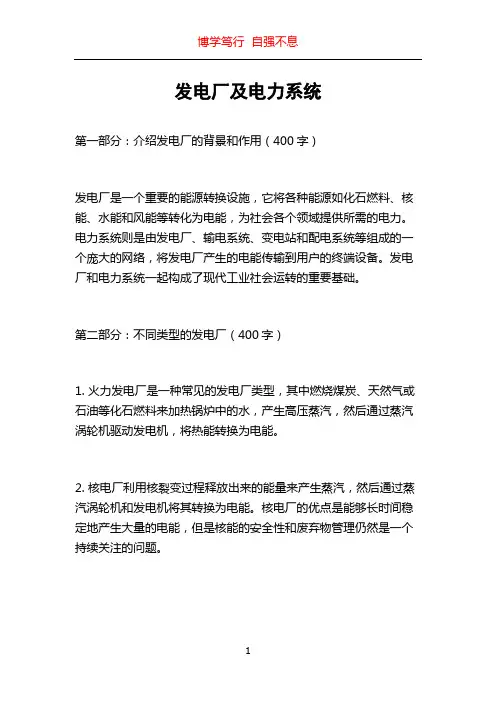
发电厂及电力系统第一部分:介绍发电厂的背景和作用(400字)发电厂是一个重要的能源转换设施,它将各种能源如化石燃料、核能、水能和风能等转化为电能,为社会各个领域提供所需的电力。
电力系统则是由发电厂、输电系统、变电站和配电系统等组成的一个庞大的网络,将发电厂产生的电能传输到用户的终端设备。
发电厂和电力系统一起构成了现代工业社会运转的重要基础。
第二部分:不同类型的发电厂(400字)1. 火力发电厂是一种常见的发电厂类型,其中燃烧煤炭、天然气或石油等化石燃料来加热锅炉中的水,产生高压蒸汽,然后通过蒸汽涡轮机驱动发电机,将热能转换为电能。
2. 核电厂利用核裂变过程释放出来的能量来产生蒸汽,然后通过蒸汽涡轮机和发电机将其转换为电能。
核电厂的优点是能够长时间稳定地产生大量的电能,但是核能的安全性和废弃物管理仍然是一个持续关注的问题。
3. 水力发电厂是利用水能来产生电能的一种可再生能源发电形式。
通过建造水坝和引导水流来控制水的流动,然后通过水轮机和发电机将水能转换为电能。
4. 风力发电厂利用风能驱动风力涡轮机来产生电能。
风力发电具有环保和可再生的优势,但它对风速和风向的依赖性限制了其应用范围。
第三部分:电力系统的组成和功能(400字)1. 发电机:发电厂中的核心设备,负责将各种能源转换为电能。
2. 输电系统:将发电厂产生的高压电能通过输电线路传输到各个地方。
3. 变电站:用于将输送中的高压电能转换为适用于不同用户的低压电能。
4. 配电系统:将电能传输到用户终端设备,如家庭、工业设施和商业建筑等。
5. 保护系统:监测电力系统和设备的运行状态,及时采取措施,以保护系统的安全和可靠运行。
6. 自动化系统:通过自动化技术实现对电力系统的监控和控制,提高其操作效率和安全性。
7. 调度控制中心:负责协调和管理整个电力系统,确保电能的平衡供应和优化调度。
第四部分:发电厂及电力系统的发展趋势(400字)随着环境保护意识的增强和对可再生能源的需求增加,发电厂及电力系统正面临着一系列的变化和挑战。
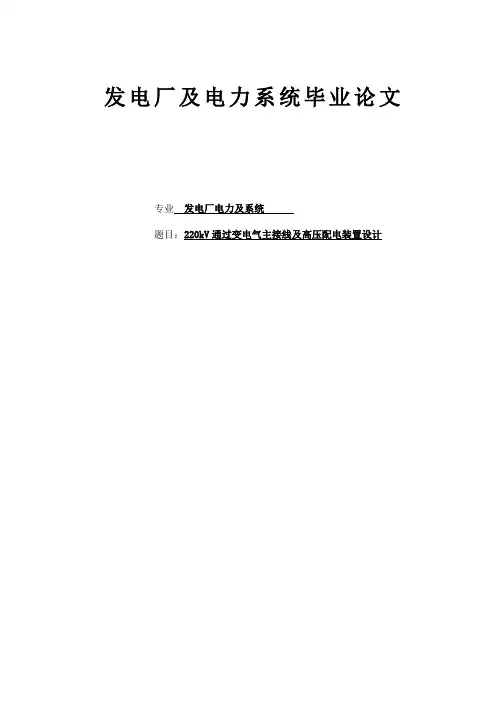
发电厂及电力系统毕业论文专业发电厂电力及系统题目:220kV通过变电气主接线及高压配电装置设计目录摘要 ---------------------------------------------------------------1 关键词 ---------------------------------------------------------------1 毕业设计任务书---------------------------------------------------------2 前言 ---------------------------------------------------------------3第一章变电所电气主接线设计 -----------------------------------------4 ξ 1-1 主接线方案选择比较确定------------------------------------------4 ξ 1-2主变压器选择----------------------------------------------------9 ξ 1-3 站用电设计------------------------------------------------------10 第二章短路电流计算 ----------------------------------------------------11 ξ 2-1 短路电流计算概述-------------------------------------------------11 ξ 2-2短路电流计算过程-------------------------------------------------12 ξ 2-3短路电流计算结果表 ----------------------------------------------17 第三章电器设备、导体选择及校验---------------------------------------17 ξ 3-1 电器设备选择标准与技术条件---------------------------------------20 ξ 3-2 断路器的选择与校验-----------------------------------------------20 ξ 3-3隔离刀闸的选择与校验---------------------------------------------24 ξ 3-4导体的选择与校验------------------------------------------------- 27 ξ 3-5电流互感器、电压互感器的选择与校验------------------------------- 32ξ 3-6户外支柱绝缘子的选择与校验--------------------------------------- 38ξ 3-7导体、电气设备的选择成果表 ------------------------------------- 40第四章变电站配电装置设计 -------------------------------------------- 41 第五章防雷保护------------------------------------------------------- 45第六章仪表及继电保护、自动装置的配置规划------------------------------ 48 ξ6-1仪表及继电保护的配置规划----------------------------------------- 48ξ 6-2 微机保护的配置规划----------------------------------------------- 49 ξ6-3 安全自动装置的配置规划--------------------------------------------52结论------------------------------------------------------------------- 54 总结体会--------------------------------------------------------------- 55谢辞------------------------------------------------------------------- 56参考文献-------------------------------------------------------------- 57[摘要]:本站是220KV的地区性通过变电站110kV侧有10回出线,负荷60MW;35kV 侧有8回出线,负荷40MW,穿越功率为30000KVA,也是本地区电网电能分配中心。
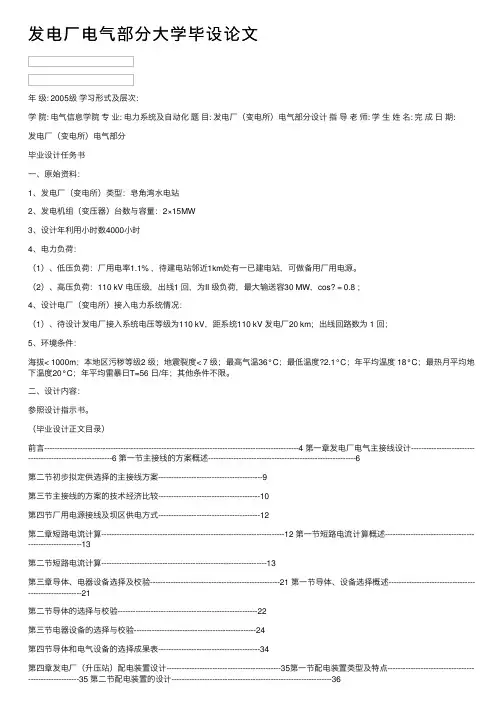
发电⼚电⽓部分⼤学毕设论⽂年级: 2005级学习形式及层次:学院: 电⽓信息学院专业: 电⼒系统及⾃动化题⽬: 发电⼚(变电所)电⽓部分设计指导⽼师: 学⽣姓名: 完成⽇期:发电⼚(变电所)电⽓部分毕业设计任务书⼀、原始资料:1、发电⼚(变电所)类型:皂⾓湾⽔电站2、发电机组(变压器)台数与容量:2×15MW3、设计年利⽤⼩时数4000⼩时4、电⼒负荷:(1)、低压负荷:⼚⽤电率1.1% ,待建电站邻近1km处有⼀已建电站,可做备⽤⼚⽤电源。
(2)、⾼压负荷:110 kV 电压级,出线1 回,为II 级负荷,最⼤输送容30 MW,cos? = 0.8 ;4、设计电⼚(变电所)接⼊电⼒系统情况:(1)、待设计发电⼚接⼊系统电压等级为110 kV,距系统110 kV 发电⼚20 km;出线回路数为 1 回;5、环境条件:海拔< 1000m;本地区污秽等级2 级;地震裂度< 7 级;最⾼⽓温36°C;最低温度?2.1°C;年平均温度 18°C;最热⽉平均地下温度20°C;年平均雷暴⽇T=56 ⽇/年;其他条件不限。
⼆、设计内容:参照设计指⽰书。
(毕业设计正⽂⽬录)前⾔----------------------------------------------------------------------------------------------------4 第⼀章发电⼚电⽓主接线设计----------------------------------------------------------6 第⼀节主接线的⽅案概述----------------------------------------------------------6第⼆节初步拟定供选择的主接线⽅案-----------------------------------------9第三节主接线的⽅案的技术经济⽐较----------------------------------------10第四节⼚⽤电源接线及坝区供电⽅式----------------------------------------12第⼆章短路电流计算------------------------------------------------------------------------12 第⼀节短路电流计算概述--------------------------------------------------------13第⼆节短路电流计算-----------------------------------------------------------------13第三章导体、电器设备选择及校验---------------------------------------------------21 第⼀节导体、设备选择概述-------------------------------------------------------21第⼆节导体的选择与校验-------------------------------------------------------22第三节电器设备的选择与校验------------------------------------------------24第四节导体和电⽓设备的选择成果表----------------------------------------34第五章继电保护、⾃动装置、测量表计及同期系统的配置规划------------------------------------------38第六章过电压保护和接地-----------------------------------------------------------------46参考⽂献---------------------------------------------------------------------------------------------48 附图:⼀、主接线⽅案⽐较图⼆、电⽓主接线图三、继电保护配置图四、⾃动装备配置图五、计算机监控系统图六、⾼压配电装置平⾯布置图七、⾼压配电装置剖⾯图(⼀)⼋、⾼压配电装置剖⾯图(⼆)前⾔⼀、本毕业设计的⽬的与要求:本毕业设计是电⽓⼯程及其⾃动化专业学⽣在完成本专业教学计划的全部课程教学、课程设计、⽣产实习、毕业实习的基础上,进⼀步培养学⽣综合运⽤所学理论知识与技能,解决实际问题能⼒的⼀个重要环节。
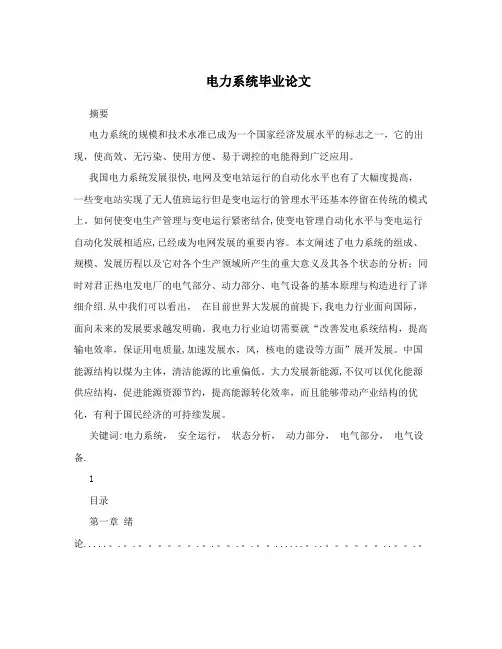
电力系统毕业论文摘要电力系统的规模和技术水准已成为一个国家经济发展水平的标志之一,它的出现,使高效、无污染、使用方便、易于调控的电能得到广泛应用。
我国电力系统发展很快,电网及变电站运行的自动化水平也有了大幅度提高,一些变电站实现了无人值班运行但是变电运行的管理水平还基本停留在传统的模式上。
如何使变电生产管理与变电运行紧密结合,使变电管理自动化水平与变电运行自动化发展相适应,已经成为电网发展的重要内容。
本文阐述了电力系统的组成、规模、发展历程以及它对各个生产领域所产生的重大意义及其各个状态的分析;同时对君正热电发电厂的电气部分、动力部分、电气设备的基本原理与构造进行了详细介绍.从中我们可以看出,在目前世界大发展的前提下,我电力行业面向国际,面向未来的发展要求越发明确。
我电力行业迫切需要就“改善发电系统结构,提高输电效率,保证用电质量,加速发展水,风,核电的建设等方面”展开发展。
中国能源结构以煤为主体,清洁能源的比重偏低。
大力发展新能源,不仅可以优化能源供应结构,促进能源资源节约,提高能源转化效率,而且能够带动产业结构的优化,有利于国民经济的可持续发展。
关键词:电力系统,安全运行,状态分析,动力部分,电气部分,电气设备.1目录第一章绪论.....。
.。
.。
.。
.。
.。
.。
......。
..。
..。
.。
..。
.。
..。
...。
.。
.。
.。
.。
...。
..。
.。
..。
.. ..。
...。
...。
...。
.。
.。
..。
......。
..。
11.1 电力系统发展历程。
..。
..。
.。
..。
..。
.。
..........。
..。
.。
.. ..。
....。
.。
....。
.。
.。
..。
....。
..。
.。
.。
.。
.。
.。
.。
........。
1 1。
2电力系统状态分析。
.。
....。
.。
.。
...。
..。
..。
.。
.。
...。
..。
.。
..。
.。
....。
......。
.。
.。
.。
.。
.。
.。
.。
..。
.。
..。
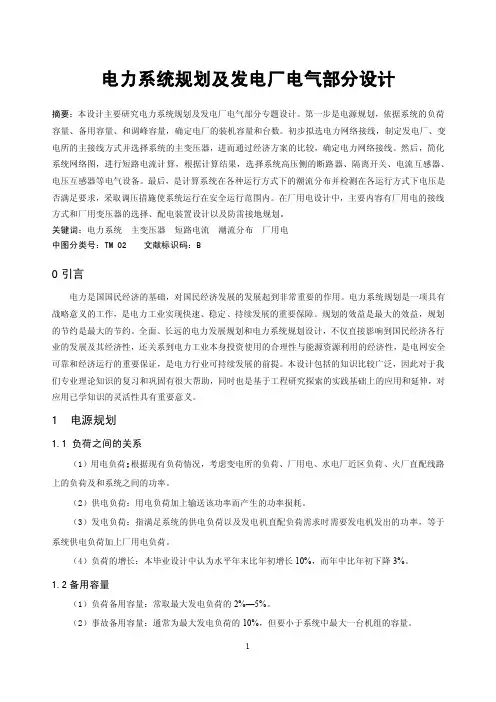
电力系统规划及发电厂电气部分设计摘要:本设计主要研究电力系统规划及发电厂电气部分专题设计。
第一步是电源规划,依据系统的负荷容量、备用容量、和调峰容量,确定电厂的装机容量和台数。
初步拟选电力网络接线,制定发电厂、变电所的主接线方式并选择系统的主变压器,进而通过经济方案的比较,确定电力网络接线。
然后,简化系统网络图,进行短路电流计算,根据计算结果,选择系统高压侧的断路器、隔离开关、电流互感器、电压互感器等电气设备。
最后,是计算系统在各种运行方式下的潮流分布并检测在各运行方式下电压是否满足要求,采取调压措施使系统运行在安全运行范围内。
在厂用电设计中,主要内容有厂用电的接线方式和厂用变压器的选择、配电装置设计以及防雷接地规划。
关键词:电力系统主变压器短路电流潮流分布厂用电中图分类号:TM 02 文献标识码:B0引言电力是国国民经济的基础,对国民经济发展的发展起到非常重要的作用。
电力系统规划是一项具有战略意义的工作,是电力工业实现快速、稳定、持续发展的重要保障。
规划的效益是最大的效益,规划的节约是最大的节约。
全面、长远的电力发展规划和电力系统规划设计,不仅直接影响到国民经济各行业的发展及其经济性,还关系到电力工业本身投资使用的合理性与能源资源利用的经济性,是电网安全可靠和经济运行的重要保证,是电力行业可持续发展的前提。
本设计包括的知识比较广泛,因此对于我们专业理论知识的复习和巩固有很大帮助,同时也是基于工程研究探索的实践基础上的应用和延伸,对应用已学知识的灵活性具有重要意义。
1 电源规划1.1 负荷之间的关系(1)用电负荷:根据现有负荷情况,考虑变电所的负荷、厂用电、水电厂近区负荷、火厂直配线路上的负荷及和系统之间的功率。
(2)供电负荷:用电负荷加上输送该功率而产生的功率损耗。
(3)发电负荷:指满足系统的供电负荷以及发电机直配负荷需求时需要发电机发出的功率,等于系统供电负荷加上厂用电负荷。
(4)负荷的增长:本毕业设计中认为水平年末比年初增长10%,而年中比年初下降3%。
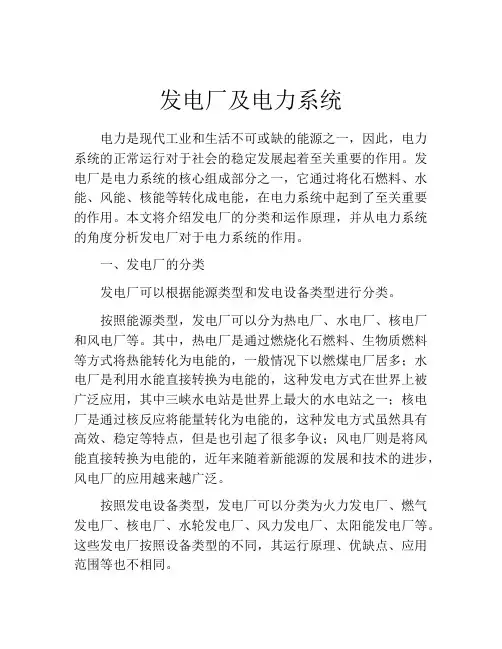
发电厂及电力系统电力是现代工业和生活不可或缺的能源之一,因此,电力系统的正常运行对于社会的稳定发展起着至关重要的作用。
发电厂是电力系统的核心组成部分之一,它通过将化石燃料、水能、风能、核能等转化成电能,在电力系统中起到了至关重要的作用。
本文将介绍发电厂的分类和运作原理,并从电力系统的角度分析发电厂对于电力系统的作用。
一、发电厂的分类发电厂可以根据能源类型和发电设备类型进行分类。
按照能源类型,发电厂可以分为热电厂、水电厂、核电厂和风电厂等。
其中,热电厂是通过燃烧化石燃料、生物质燃料等方式将热能转化为电能的,一般情况下以燃煤电厂居多;水电厂是利用水能直接转换为电能的,这种发电方式在世界上被广泛应用,其中三峡水电站是世界上最大的水电站之一;核电厂是通过核反应将能量转化为电能的,这种发电方式虽然具有高效、稳定等特点,但是也引起了很多争议;风电厂则是将风能直接转换为电能的,近年来随着新能源的发展和技术的进步,风电厂的应用越来越广泛。
按照发电设备类型,发电厂可以分类为火力发电厂、燃气发电厂、核电厂、水轮发电厂、风力发电厂、太阳能发电厂等。
这些发电厂按照设备类型的不同,其运行原理、优缺点、应用范围等也不相同。
二、发电厂的运作原理发电厂的运作原理一般可分为三个步骤:发电机、输电和配电。
1、发电机发电机是一台将运动能转化为电能的装置,一般由定子和转子两个部分组成。
定子由金属片、绕组和绝缘材料等组成,转子由磁性材料制成。
发电机的基本原理是利用密绕线圈受到的磁场感应出电流,即发电机的工作原理是通过在磁场中转动线圈来产生电流。
通过燃烧燃料、水能、风能等方式产生的机械能被传递给转子,使转子在磁场中旋转,由此在定子中产生一定电压的电流,进而输出电能。
不同类型的发电厂转子的转动方式不相同,但是其转动最终都会使得定子感应出电流输出电能。
2、输电输电是将发电厂产生的电能通过电缆、铁塔等输送到用电地方的过程。
电能输送的距离和负荷的大小决定了输电线路的种类和所用材料的质量。
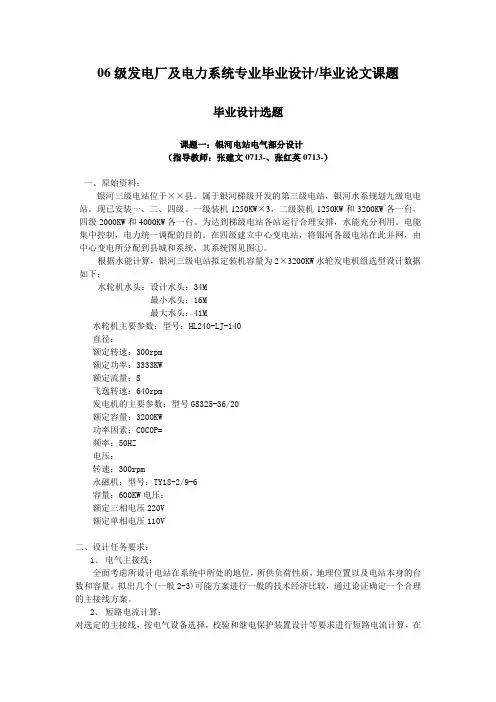
06级发电厂及电力系统专业毕业设计/毕业论文课题毕业设计选题课题一:银河电站电气部分设计(指导教师:张建文0713-、张红英0713-)一、原始资料:银河三级电站位于××县。
属于银河梯级开发的第三级电站,银河水系规划九级电电站。
现已安装一、二、四级。
一级装机1250KW×3,二级装机1250KW和3200KW各一台,四级2000KW和4000KW各一台。
为达到梯级电站各站运行合理安排,水能充分利用。
电能集中控制,电力统一调配的目的。
在四级建立中心变电站,将银河各级电站在此并网,由中心变电所分配到县城和系统,其系统图见图①。
根据水能计算,银河三级电站拟定装机容量为2×3200KW水轮发电机组选型设计数据如下:水轮机水头:设计水头:34M最小水头:16M最大水头:41M水轮机主要参数:型号:HL240-LJ-140直径:额定转速:300rpm额定功率:3333KW额定流量:S飞逸转速:640rpm发电机的主要参数:型号GS325-36/20额定容量:3200KW功率因素:C0C0P=频率:50HZ电压:转速:300rpm永磁机:型号:TY18-2/9-6容量:600KW电压:额定三相电压220V额定单相电压110V二、设计任务要求:1、电气主接线:全面考虑所设计电站在系统中所处的地位,所供负荷性质,地理位置以及电站本身的台数和容量。
拟出几个(一般2-3)可能方案进行一般的技术经济比较,通过论证确定一个合理的主接线方案。
2、短路电流计算:对选定的主接线,按电气设备选择,校验和继电保护装置设计等要求进行短路电流计算,在教师指导下,力求合理选择计算短路点,以避免过多的重复计算工作量。
3、电气设备选择与校验:不要求所有电气设备逐一进行选择校验,但应对各类相同设备选择其中2-4个主要的进行选择校验,其他可以参照有关资料粗略估计定出型号。
4、厂用电、防雷保护、接地装置、通讯与照明:除厂用电的高压侧接线方式在电气一次接线图中表明外,其他内容可只考虑大致设计原则方案,在设计说明书中作文字或简图说明。
发电厂电力初级系统设计-毕业论文
简介
本文旨在讨论发电厂电力初级系统的设计,主要介绍设备的选型和电力系统的布置。
我们针对电力系统工程师和相关从业人员,为设计和施工提供指导。
设备选型
发电厂的电力系统包括变压器、开关设备、电缆和配电盘。
变压器和开关设备的功能是将电压从高电压电网降至发电机和运行设备所需的电压。
建议选用质量可靠的品牌,以确保运行安全和节省维护成本。
对于电缆和配电盘的选择,应优先考虑材料质量和可靠性,以确保长期使用安全。
电力系统布置
发电厂电力系统布置主要涉及主变压器和配电室的位置选择。
根据发电厂布局和电力系统工程图纸,主变压器和配电室应尽可能靠近发电机,并考虑到电力系统的可靠性和维护成本。
结论
通过对发电厂电力初级系统设计的讨论和分析,我们得出以下结论:在设备选型和布置方面,需要考虑质量可靠性和长期维护成本。
同时,为了确保电力系统的可靠性和维护便利性,主变压器和配电室应尽可能靠近发电机位置。
以上是对发电厂电力初级系统设计的讨论,希望能对电力系统工程师和相关从业人员提供帮助。
发电厂及电力系统毕业论文发电厂及电力系统毕业论文随着工业化和城市化的迅速发展,电力成为现代社会不可或缺的能源之一。
发电厂及电力系统作为电力供应的核心,对于保障电力供应的稳定性和可靠性起着至关重要的作用。
本文将从发电厂的类型、电力系统的组成以及未来发展方向等方面探讨发电厂及电力系统的相关问题。
一、发电厂的类型发电厂是指将各种能源转化为电能的设施,根据能源的不同,发电厂可以分为热电厂、水电厂、风电厂、太阳能发电厂等。
热电厂主要利用化石燃料或核能产生高温高压的蒸汽,通过蒸汽驱动涡轮发电机组发电。
水电厂则利用水能转化为机械能,再通过发电机组转化为电能。
风电厂则利用风能驱动风轮发电,太阳能发电厂则利用太阳能转化为电能。
不同类型的发电厂具有各自的特点和优势。
热电厂在能源的选择上较为灵活,可以利用多种能源进行发电,但是存在环境污染和能源消耗等问题。
水电厂则具有清洁、可再生的特点,但是受到水资源和地理条件的限制。
风电厂和太阳能发电厂则具有无污染、可再生的特点,但是受到天气条件的限制。
二、电力系统的组成电力系统是指由发电厂、输电线路、变电站和配电网等组成的供电系统。
发电厂将电能产生后,通过输电线路将电能传输到变电站,再由变电站进行变压、分配和控制,最终通过配电网将电能供应给用户。
电力系统的组成非常复杂,其中输电线路是电能传输的关键环节。
输电线路分为高压直流输电和交流输电两种形式。
高压直流输电具有输电损耗小、输电距离远等优点,但是设备成本高,维护困难。
交流输电则分为高压交流输电和低压交流输电,高压交流输电具有输电损耗小、设备成本低等优点,但是输电距离有限。
变电站是电力系统中的重要环节,主要负责电能的变压、分配和控制。
变电站根据电压等级的不同,可以分为220kV变电站、110kV变电站、35kV变电站等。
变电站的设计和运行对于电力系统的稳定性和可靠性具有重要影响。
三、未来发展方向随着能源危机和环境问题的日益突出,未来发电厂及电力系统的发展方向将更加注重清洁、可再生能源的利用。
吉林电子信息职业技术学院毕业设计论文论文题目:风力发电原理及前景概述学院:机电技术学院专业:发电厂及电力系统班级:学生姓名:学号:指导教师:2014 年 6 月20 日风能是太阳能的一种转换形式,是一种重要的自然能源。
太阳照射到地球表面,地球表面各处受热不同,产生温差,从而引起大气的对流运动形成风。
据估计到达地球的太阳能中虽然只有大约2%转化为风能,但其总量仍是十分可观的。
全球的风能约为2.74×109MW,其中可利用的风能为2×107MW,比地球上可开发利用的水能总量还要大10倍.风能作为一种无污染、可再生的绿色能源,它对于解决全球性的能源危机和环境危机有着重要的意义。
因此,风力发电成为各国学者研究的重点。
目前,国内学者对大型风力发电的研究已日趋成熟,但对于实验室风力发电机的研制还是比较欠缺的。
本次毕业设计的重点是拟设计简易的风力发电,该设备能让学生容易了解风力发电的原理,以及大致测算出影响风力发电的各个因素,方便以后的大学物理实验教学,同时在制作和测试过程中对出现的一些现象进行深刻的思考,具有很强的实用性和趣味性。
在研制的过程中,同时对风能的转化功率,风速等影响发电的因素,进行测量,并与理论进行对比,进而得出影响效率的因素。
摘要 .................................................................... 第一章风力发电概述 . 01。
1 风力发电的背景 01.2 风力发电的现状 01。
3 风力发电的潜力 (1)1.4 风力发电的意义 (2)第二章风力发电机 (3)2。
1 风力发电机的构成 (3)2.2.1 恒速风力发电机 (3)2.2.2 有限变速风力发电机 (4)2。
2。
3 变速风力发电机 (4)2.3 不同风力发电机的综合比较 (5)2。
3.1 年能量利用率和经济性的对比分析 (5)2.3.2 不同类型风力发电机市场应用情况 (6)第三章风力发电控制技术 (7)3.1 定桨距失速风力发电技术 (7)3.2 变桨距风力发电技术 (7)3。
发电厂毕业论文发电厂毕业论文随着经济的快速发展和人口的不断增加,电力需求也呈现出了爆发式的增长。
作为能源供应的重要组成部分,发电厂在现代社会中扮演着至关重要的角色。
因此,我选择了发电厂作为我的毕业论文的主题,希望通过深入研究,探索发电厂的运营机制、环境影响以及未来发展方向。
首先,我将从发电厂的运营机制入手。
发电厂的运营涉及到多个方面,包括能源供应、设备维护、燃料采购等。
在能源供应方面,发电厂可以选择不同的发电方式,如化石燃料发电、核能发电、可再生能源发电等。
每种发电方式都有其优势和劣势,而选择合适的发电方式对于发电厂的经济效益和环境影响至关重要。
在设备维护方面,发电厂需要定期检修设备,确保其正常运行和安全性。
而燃料采购则需要考虑成本、供应稳定性以及环境友好性等因素。
其次,我将探讨发电厂对环境的影响。
发电厂的运营不可避免地会产生大量的废气、废水和固体废物。
这些排放物对环境和人类健康都带来了一定的风险。
例如,化石燃料发电会产生大量的二氧化碳,加剧全球变暖问题;核能发电则会产生放射性废物,对环境和人体健康构成潜在威胁。
因此,发电厂需要采取有效的措施来减少排放物的产生和对环境的影响,如安装污染治理设施、提高能源利用效率等。
此外,我还将探讨发电厂的未来发展方向。
随着可再生能源的快速发展和技术的不断进步,发电厂的未来发展将趋向于清洁、高效和可持续。
可再生能源发电将成为主流,如太阳能发电、风能发电等,这些能源具有取之不尽、用之不竭的特点,且几乎不产生污染物。
同时,发电厂还可以通过提高能源利用效率、采用先进的燃烧技术等手段来减少排放物的产生。
此外,发电厂还可以与智能电网相结合,实现能源的高效调配和灵活运营。
综上所述,发电厂作为能源供应的重要组成部分,其运营机制、环境影响以及未来发展方向都是我毕业论文的研究内容。
通过深入研究发电厂的相关问题,我希望能够为发电厂的运营和发展提供一些有益的思考和建议。
同时,我也希望通过我的研究,能够加深人们对发电厂的认识,提高对能源问题的关注和环保意识,为构建可持续发展的社会做出贡献。
1 引言近年,我国电力工业发展迅速,电力供给能力显著增强。
“十五”期间全国发电装机新增近2亿千瓦,创历史最高水平,2006年又新增装机容量1亿千瓦,总容量超过6亿千瓦,今年投产规模仍将保持在7000万千瓦以上,全国电力供给紧张的局面已经得到全面缓解。
但是,我国电力工业结构不合理的矛盾仍十分突出,特别是能耗高、污染重的小火电机组比重过高。
因此,电力工业将“上大压小”、加快关停小火电机组放在了“十一五”期间工作的首位[9]。
据测算,火电机组容量的不同,反映在煤耗和污染物排放量上差异很大。
大型高效发电机组每千瓦时供电煤耗为290克--340克,中小机组则到达380克--500克。
5万千瓦机组其供电煤耗约440克/千瓦时,发同样的电量,比大机组多耗煤30--50%。
与此同时,小火电机组排放二氧化硫和烟尘排放量分别占电力行业总排放量的35%和52%。
国家发改委能源局局长赵小平算了一笔账,“现有的小机组假设能够完全由大机组替代,一年可节能9000万吨标准。
目前全国10万千瓦及以下小火电机组占火电装机比重到达29.4%,这些小火电绝大部分是在我国电力供给较为紧张的“八五”、“九五”期间建设的,主要分布于经济发达地区和煤炭资源丰富的省份。
加速关停小火电机组,一方面是保证节能降耗指标的完成,另一方面有助于保障大机组的开工率,促进电力产业结构改造升级。
关停小火电机组是从国家大局出发,优化电力工业结构的重要举措,对提高电力工业的整体质量和效益,促进电力工业可持续发展具有十分重要的意义。
发电厂二期工程电气部分设计①装机容量:装机两台,总容量600MW;②机组年利用小时数: Tmax=6000小时③气象条件:发电厂所在地最高气温32℃,年平均气温5.65℃,最大风速25m/s④厂用电率:按6%考虑⑤ 220kV电压等级,架空线路2回与系统相连,系统电抗以100MVA为基准折算到220k 设计基本要求:①确定发电厂电气主接线的最正确方案〔包括主变压器型式、容量的选择〕;②确定发电厂厂用电接线的最正确方案;③计算短路电流;④事故保安负荷计算、电气设备的配置方案;⑤电气设备的选择与校验;⑥绘制有关图纸〔电气主接线图、配电装置平面图与断面图等〕;2 电气主接线2.1 概述主接线设计必须结合电力系统和发电厂的具体情况,全面分析有关因素,正确处理它们之间的关系,最后合理确定主接线的方案[5]。
大学毕业论文电力系统短期负荷预测姓名:学号:专年级:指导教师:目录中文摘要: (1)英文摘要: (2)1绪论 (3)1.1 短期负荷预测的目的和意义 (3)1.2电力系统负荷预测的特点和基本原理 (4)1.2.1电力负荷预测的特点 (4)1.2.2电力负荷预测的基本原理 (4)1.3 国外研究的现状 (5)1.3.1 传统负荷预测方法 (6)1.3.2 现代负荷预测方法 (6)1.4 神经网络应用于短期负荷预报的现状 (8)1.5 本文的主要工作 (8)2最小二乘法 (10)2.1 最小二乘法原理 (10)2.2 多项式拟合具体算法 (10)2.3多项式拟合的步骤 (11)2.4 电力系统短期负荷预测误差 (12)2.4.1 误差产生的原因 (12)2.4.2 误差表示和分析方法 (12)2.4.3 拟合精度分析 (13)3基于神经网络的短期负荷预测 (15)3.1 人工神经网络 (15)3.1.1 人工神经网络的基本特点 (15)3.2 BP网络的原理、结构 (15)3.2.1网络基本原理 (15)3.2.2 BP神经网络的模型和结构 (16)3.2.3 BP网络的学习规则 (16)3.3 BP算法的数学描述 (17)3.3.1信息的正向传递 (17)3.3.2 利用梯度下降法求权值变化及误差的反向传播 (17)3.4 BP网络学习具体步骤 (18)3.5 标准BP神经网络模型的建立 (19)3.5.1 输入输出变量 (19)3.5.2 网络结构的确定 (19)3.5.3 传输函数 (20)3.5.4 初始权值的选取 (21)3.5.5 学习数率 (22)3.5.6 预测前、后数据的归一化处理 (22)3.6 附加动量的BP神经网络 (22)3.6.1 标准BP算法的限制与不足 (22)3.6.2 附加动量法 (23)4算例分析 (25)4.1 负荷数据 (25)4.1.1 14天实际的负荷数据 (25)4.1.2 归一化后的负荷数据 (27)4.2 两个模型仿真后的结果分析 (30)4.3 两种模型拟合精度分析 (37)4.4 附加动量法 (39)结论 (40)谢辞 (41)参考文献 (42)附录1 最小二乘法的MATLAB程序 (44)附录2 标准BP神经网络的MATLAB程序 (46)附录3 附加动量法的MATLAB程序 (49)电力系统短期负荷预测摘要:电力系统负荷预测是电力生产部门的重要工作之一。
准确的负荷预测,可以合理安排机组启停,减少备用容量,合理安排检修计划及降低发电成本等。
准确的预测,特别是短期负荷预测对提高电力经营主体的运行效益有直接的作用,对电力系统控制、运行和计划都有重要意义。
因此,针对不同场合需要寻求有效的负荷预测方法来提高预测精度。
本文采用神经网络方法对电力系统短期负荷进行预测。
本文主要介绍了电力负荷预测的主要方法和神经网络的原理、结构,分析了反向传播算法,建立三层人工神经网络模型进行负荷预测,并编写相关程序。
与此同时采用最小二乘法进行对比,通过对最小二乘法多项式拟合原理的学习,建立模型编写相关程序。
通过算例对两种模型绝对误差、相对误差、拟合精度进行分析,同时比较它们训练时间,得出标准BP神经网络具有更好的精度优势但训练速度较慢。
最后针对标准BP神经网络训练速度慢、容易陷入局部最小值等缺点,对标准BP神经网络程序运用附加动量法进行修改,分析改进后网络的优点。
关键词:短期负荷预测, 标准BP神经网络,最小二乘法,附加动量法The Short-Term Load Forecasting ofthe power systemAbstract:Power system load forecasting is one of the most important work of the electricity production sector. The accurate loadforecasting can arrange unit start-stop, reduce the spare capacity,reasonable arrangement of the maintenance plan and reduce power cost,etc. It has a direct effect on the running efficiency of the powermanagement entities and also has the important meaning in the powersystem control, operation and planning. So it is important to findeffective method to enhance forecast precision for differentoccasions. In this paper the neural network is used for the short-termload forecasting of the power system. This article introduces themethod of the power load forecasting and the principles, structure,back-propagation algorithm of the neural network. Then thethree-layer artificial neural network model is created for loadforecasting and the program is written. At the same time, the leastsquare method is used for comparing. By learning the polynomialfitting principle of the square method, the model is created and theprogram is written. Through comparing the absolute error, therelative error, the fitting precision and their training time of thetwo models, the BP neural network is proved to have better accuracybut slower training speed. Due to the standard BP neural network hasslower training speed, easy to fall into the local minimum value andother shortcoming, the additional momentum method is used to modifythe standard BP neural network and the advantage of the improvednetwork is concluded.Keywords:Short-term load forecasting Standard BP neural network Least squares method Additional momentum method1 绪论1.1 短期负荷预测的目的和意义短期负荷预测可对未来一天到七天的负荷进行预测,是调度中心制定发电计划及发电厂报价的依据。
它也是能量管理系统(EMS)的重要组成部分,对电力系统的运行、控制和计划都有着非常重要的影响,提高电力系统短期负荷预测的精度既能增强电力系统运行的安全性,又能改善电力系统运行的经济性。
电力系统负荷预测是以准确的统计数据和调查资料为依据,从用电量的历史和现状出发,在充分考虑一些重要的系统运行特性、增容决策,自然条件与社会影响的条件下,研究或利用一套系统地处理过去与未来负荷的数学方法。
在满足一定精度要求的意义下,确定未来某特定时刻的负荷数值[1]。
电力负荷预测的目的就是提供负荷的发展状况和水平,为电力生产部门和管理部门制订生产计划和发展规划提供依据,确定各供电地区的供电电量,生产规划等等。
随着我国电力市场的进一步发展,短期负荷预测在电力系统的经济运行方面的影响会愈来愈明显,尤其对发电市场侧有深远影响,主要表现在:(1) 短期负荷预测值对实时电价制定的影响。
电价是电力市场的杠杆和核心容,体现了电力市场的竞争性和开放性,而电价的制定是在未来给定电价计算期的负荷预测的基础上完成的。
因此,发电企业要保证其电价的竞争能力并且盈利,就必须获得较精确的负荷预测,才能订出既有竞争力又保证盈利的电价。
(2) 短期负荷预测值对用户用电情况的影响。
由于负荷的随机变化,或发、输、配电设备的故障,电能的供、需情况是不断变化的,供电成本也是随之变化的。
即使是同一用户,不同时间用电时,对其供电的成本也是不同的。
短期负荷预测结果的出现,使用户可以了解负荷高峰和低谷出现的时间以便合理安排用电情况,节约电费;而且用户可以相应地对电价做出响应,选择低电价时段用电。
(3) 短期负荷预测对转运业务的影响。
提供转运业务是电力市场中电网的一项基本功能,转运是电力市场平等竞争的必要条件,可以给电网带来巨大的效益[2]。
而电网在执行转运业务时,将根据负荷预测的数据及各发电机的运行参数,制定发电计划和调度计划,所以准确的负荷预测将促进供、运、用电三方的协调。
(4) 短期负荷预测对合同电量分配的影响。
由于在初级发电市场,所有电量统一进行竞价,只在电费结算时考虑合同电量,按照差价合约结算。
由于电费结算按时段进行,需将合同电量按负荷预测曲线分配至各时段。
在最后是按短期负荷预测曲线将日合同电量分到各时段,所以不准确的短期负荷预测将导致违约,甚至引起电量分配的不合理,造成电量不足等问题。
(5) 短期负荷预测对系统充裕性评估的影响。
系统充裕性评估(Projected Assessment of System Adequacy)由电力调度中心负责,主要容是分析预测中、短期系统供需平衡和系统安全情况,目的是让市场成员正确了解信息,安排1年中系统的供电、用电及设备检修,进行发电报价决策,以尽可能减少电力调度中心的干预。
这也体现了准确的短期负荷预测对系统及发电市场的重要影响和作用。
1.2电力系统负荷预测的特点和基本原理1.2.1电力负荷预测的特点这于负荷预测是根据电力负荷的过去与现在来推测它的未来数值,所以,这一工作所研究的对象是不确定性事件,它具有以下特点:(1) 预测结果的非准确性。